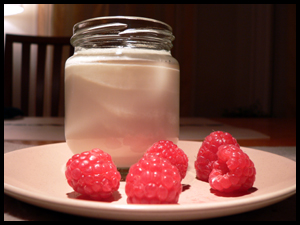
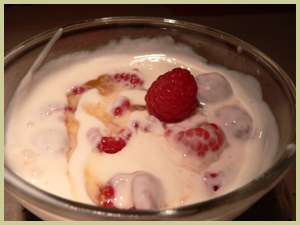
The following topic, yogurt making, has always been very central to animated conversations in which, I do not know why, I would throw myself deeply into, and find myself talking passionately about how important a good yogurt is, and how difficult it is to find one generally speaking in regular supermarkets here. Now no offense here–I think I am starting one of those animated conversations here, so stop me before it is too late–, but when I first arrived in the US about, yes, already 7 years ago, I was amazed to find the cold food sections where yogurts are displayed, looking as barren as an apple tree after harvest is over. “Nothing to buy!” did I think. Where are the Bio Bifidus, the Gervais, or the BA or the Mamie Nova? Terrible! Compared to the walls of cereals. I mean, yes of course, you find brands like Dannon or Yoplait (which equivalents in France are totally different, although they bear the same brand name), but what terrible taste. Most likely, there is no fat, and a lot of sugar, that is a taste I cannot even describe if I try to.
I kept repeating the same old song and story to my friends “you know, our yogurts are so different, they taste like…”, and they would look at me with this smile most likely thinking, “yeah, we believe you!”, that was enough to tell me they did not buy a word of my bragging about our savoir-faire in yogurt making.
Until one day!
One of my very good friends went to France for the first time, and of course, after hearing so much about yogurts in our endless yogurt debates, she made a point to see for herself about the whole deal about French yogurts. To my joy and excitement, at her return, she came back with the best news. Not only did she believe me at last, but she made a point to tell all of our friends, the ones in those same yogurts discussions, soon to become seminars, which was the easiest way to validate, that yes, I was right!
Let’s summarize here: you can actually find good yogurts (I am looking at plain yogurts here), and amongst those, I would put a few brands like Liberty (from Canada), Fage for its nice greek yogurts and Erivan, with a few others, but they are scarce. For sure, I was on a mission and was determined to find a good old remedy to always make sure my craving for yogurts would be fulfilled, that same one which could bring back the memories of my mum making yogurts at home with her Tupperware kit.
The key was : buy a yogurt maker!
It all started there. On my way to the mall, one day, I ended up at Sur La Table– not sure how that happened,– and discovered (I must have looked like a girl seeing the beach for the first time) a yogurt maker.
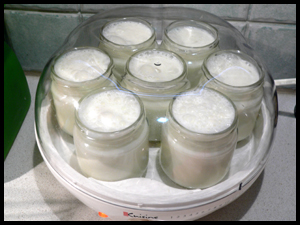
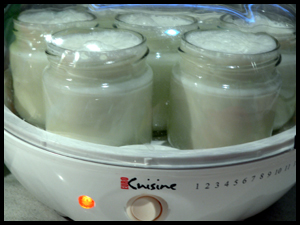
I rushed home and was all decided to test it right away. Great news, it worked perfectly. The ritual was started: about 2 times a week, it would deliver 7 little individual yogurts after a wait time of 8 hours (+3 to refrigerate before eating). This might seem long, but it is nothing really since while the yogurts are slowly “becoming” yogurts, you do not have to do a thing. Mainly, you simply have to not forget to place them in the fridge after 8 hours. This is key.
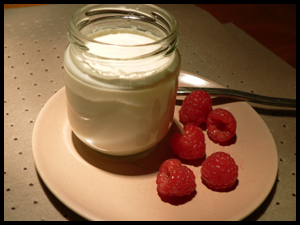
I tried a few combinations to make the yogurts. You can use a starter, which can also be purchased at Sur La Table, but I prefer to use the following combination:
- 1 plain Greek yogurt (full fat, that is 20g)
- 4 cups of Organic 2% milk
And that is it! To do it, simply boil the milk and then let rest until it reaches room temperature. Remove the skin formed on top and mix with the yogurt. Pour into the individual glass jars and start the yogurt maker. Set a timer for 8 hours and then, go and do your errands!
Eating plain yogurts with maple syrup and fresh berries is a very simple dessert, but so elegant and fulfilling! As my friend who had gone on her yogurt search in France pointed out at me, she understood why we did not need the very sweet complex desserts on a regular basis. A dessert like the one described above fulfills pleasure of taste. Le paradis, quoi!

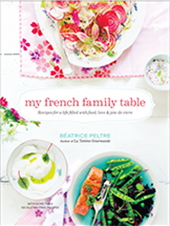
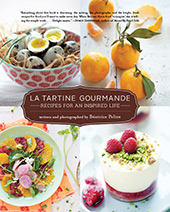
I have always heard that about french, yogurt. At least they can something right.
I’ve been considering getting a yoghurt maker for a while, but now I’m totally inspired. You make homemade yoghurt sounds so good: natural, pure, delicious and easy to make. Mmmm!
Hello,
I come from Grrece and have been making yogurt for the last 15 years using my grandmother’s recipe. Unless you want to make somebody sick you should not publish recipes that are not complete with temp. control for the milk, steralizing the jars, etc. Please visit Dr. Fankhauser’s cheese and yogurt making website at the link below recipes that are taking into consideration food safety! Cultured dairy products is not something that you should undertake lightly unless you know the basics of food safety and sanitation! In addition, what does “room temperature” mean? What about if a person leaves in Arizona and someone elese leaves in Alaska? I believe that you should have spent less time talking about how great French yogurt is (I believe that the best yogurt is the Bulgarian one) and more time giving your readers a “real recipe”…Thanks!
http://biology.clc.uc.edu/fankhauser/cheese/yogurt_making/YOGURT2000.htm
Alexia,
We all have different opinions as to what yogurt we prefer, and it is great to hear that you have a recipe that works for you. I am not claiming French yogurt is the best by any means, I was simply expressing a preference. As to giving more details as to the recipe, I followed the instructions provided with the yogurt machine I purchased (pretty vague as well by the way as far as temperature goes), which everyone should do when purchasing an appliance. Perhaps more info can be found through the link that you provided and that is a good thing.
Sur La Table does not carry a yogurt maker!
You do not need a yogurt maker to make homemade yogurt !!
Just do a Google search “making homade yogurt without a yogurt maker” or visit this website to find out how to make yogurt without any gadgets!
http://biology.clc.uc.edu/fankhauser/cheese/yogurt_making/YOGURT2000.htm
Bea, I am wondering if you add anything like cultures to your yogurt? I have been wanting to try making it at home for some time now, but have never quite gotten around to it. pMy artner eats about 1 1/2 C. every morning for breakfast, so the yogurt maker might not be the best idea (and yes, hehe, *my* Sur la Table carries them – perhaps it’s a regional thing) as i would need to buy two or three!!
Anyhow, to the point, because he and I both cannot digest dairy very well, it’s important that our yogurt be rather cultured (which help to digest). Do you have any suggestions? Is this something one has to add? Or is this something that is naturally developed as part of making the yogurt?
And I must agree, I adore French yogurt! 🙂 Personally, I also love Pavel’s Russian Style Yogurt (available in the US). No pectin, no sugar, not a single additive. But one or two more cultures than normal American yogurt, so it has a zingy taste on the tongue. Very different than any others I’ve tried. I highly recommend!
Julie, which Sur La Table did you find the yogurt maker? I would love to put my hands on a couple of them. Although I personally do not use a yogurt maker, I think they would make a great gift idea for some of my friends, who are interested in making yogurt but prefer the ease of using a yogurt maker! I can get them on line from other manufacturers but I hate shopping on the Internet! Call me an “old fashioned” Greek!
Regarding your question about introducing cultures to the yogurt…As long as you use a starter with “active (live) cultures” in it and incubate your yogurt at properly (correct temperatures, sanitary conditions, etc.) you do not need to worry about your final product…it will have plenty of healthy active cultures! For more information and a simple step by step method of making yogurt at home please visit the following link…Please do not let the word “biology” on the link intinidate you – it is not written in scientific terminology and it comes with lots of photos! By the way, with their method you do not need a yogurt maker!…For a full proof yogurt culture, use Dannon Plain yogurt, or Liberte Plain Yogurt (Canadian), or Greek Fage Total Plain Yogurt. All of those yogurts have live cultures and not one spec of additives. Also you may want to check out a company by the name NATREN, which sells probiotics, yogurt starter cultures, etc. I have used their Bulgarian Yogurt Starter Culture, which prodeces yogurt very similar to the Russian yogurt that you like!
Let me know how it turns out if you decide to make your own yogurt soon…And, do not get discouraged!…I have ruined a couple of batches myself before I got the hang of it!
Julie, Here is the link that I mentioned in my previous posting:
http://biology.clc.uc.edu/fankhauser/cheese/yogurt_making/YOGURT2000.htm
Julie,
sorry for the late reply. I do not add any cutlures to my yogurt. I use a Greek style yogurt instead as a starter, with whole milk. Did you know by the way that th best milk to digest is goat milk? You should try with this one, if you can tolerate the taste. I personally like!
And yes, my Sur La Table carries the maker too 😉 Good luck, let me know how it turns out if you try! I use one full Greek Style yogurt for 4 cups of milk (2%)
The key to yogurt making is temperature control, one of the reasons your yogurt maker(I have the same model) is so good is that it keeps the correct incubation temperature. An accurate thermometer is essential, fresh whole milk is” scalded “(i.e.82 degrees celcius)
for 2/3 minutes it must then be cooled to 42/44 degrees celcius.too high a temperature will kill the bugs, too low and the brew time is too long resulting in bitter yogurt. In Europe we have good quality UHT milk which obviates the need to pre heat, I use full fat (98.2% fat free) with a table spoon of skimmed milk powder for extra body, the powderd freeze dried cultures I use are made in Canada by Yogourmet
The incubation time is 4 (FOUR) hours, resulting in beautiful thick & mild yogurt EVERY time. I Europe yogurt manufacturers can under the guise of being “technologically justified” add stabilisers and thickeners to PLAIN YOGURT, without having to state this on the label, as I understand it the Greek brand Total, is the only one that does not muck about with its product.
It is also worth repeating that cleanliness is very important, all bits of kit including the pan you heat the milk in must be sterilized with boiling water.
FRENCH WOMEN DON’T GET FAT By Mireille Guiliano
The Yogurt Element:
http://www.cbsnews.com/stories/2005/01/12/earlyshow/leisure/books/main666448.shtml
For those of you, who may be interested in “flavored homenade yogurt”, you can find a variety of recipes at the website below….”Exquisite”, indeed !!!!
http://yaourtsamania.canalblog.com/archives/2006/12/index.html
It’s true, you don’t need a yogurt maker. You really only need a cooler! I took pictures and put together this guide. The yogurt turned out perfect and really tastes delicious. And cheap! 32 cents per cup.
http://hubpages.com/hub/How_to_make_your_own_yogurt_-_An_illustrated_guide
From the More-With-Less Cookbook, I learned that a closed oven with the light on makes a good incubator for yogurt. I use a ceramic or stainless steel bowl covered with a ceramic plate to hold the heat. I stick in a batch (made from powdered milk, water, and culture from the previous batch) in the lighted oven before I go to bed. In the morning, it’s perfect yogurt. It is my understanding that there is no need to scald the milk if it is made from powdered milk. It’s so easy. I get the powdered milk at the Aldi stores which comes out to 10 cents a cup. It takes me all of a minute to whisk together the warm water, powdered milk, and yogurt starter. I do love draining it for yogurt cheese.
It is still a good idea to boil the milk even if it is reconstituted from milk powder. Every time you open your powder milk container some bad airborne bacteria, spores, etc. may contaminate the dry milk. Boiling the reconstituded milk kills the bad bacteria, which would otherwise contaminate your yogurt. Even if you are absolutely certain that your dry milk powder is free from any airborne bacteria, etc. it is advisable that you boil the water that you use to mix the milk powder with. Taken into consideration that the milk-yogurt mixture must stay at temperatures way below the safe food holding temperature zone one must make sure that contaminants are eliminated to the highest degree possible. I agree, yogurt cheese is absolutely delicious… 🙂
This inspired me to buy my own yogurt maker (the euro cuisine that you have) after I searched online to find an alternative to spending so much money on Fage. I made my first batch last night and, even though I made a few mistakes, it still came out way way better than American store bought yogurt. I can’t wait to experiment more so please let me know if you have any tips or cool recipes. Thanks!
I have a yogurt maker too, but have never used it so far. Here in Germany you just can get too many good yogurts at the super market. But I should try it soon as we do eat a lot of yogurt.
Hey there!
I’ve tried making home made but I keep getting a ‘gunge’ i.e. a viscous, gelatinous (but lovely tasting) yoghurt. I have to admit the appearance doesn’t make me want to eat it…any ideas??? (I heat milk to boiling then left to cool to 35-45°C. Then added yoghurt and put in bain marie at 45°C in pressure cooker (not on stove but just to keep the heat in) and left over night)…really gooey, yuk! Have tried with raw milk AND then with pasteurised and same results….help!!!
Julie
Julie, please check this website. It comes with easy to follow instructions and many helpful photos. I think this is the best method to master the basics regarding yogurt making. Once you make it using this recipe then you can experiment with varying the incubation time and temperature – the longer the time and the higher the temperature the more tart the yogurt becomes. Using a crockpot is not a good idea unless it has a setting for 105-115 degrees F (proper incubation temperature range). If you incubate at temperatures much higher than that your yogurt comes out like sour cottage cheese. Also, if you incubate at temp lower than 100-105 F your yogurt will not coagulate or it will come out watery. Please have all your equipment ready beforehand so that you do not allow the temp to drop too much after adding the culture. If you do not want to fuss with the water cooler method as Dr. Fankhausser illustrates, you may just put one glass jar with boiling water inside the cooler (be careful not to let it touch the yogurt jars). Place a trerrycloth towel over the jars, close the cooler, and then wrap the cooler itself with a blanket or two keeping it away from any air drafts. Here is my favorite recipe and method. The only thing that I change is the incubation time. I like tart yogurt, so I incubate for 8-10 hours. Good luck!!
http://biology.clc.uc.edu/fankhauser/cheese/yogurt_making/YOGURT2000.htm
Julie, I am sorry – I just noticed that you let the milk cool down to 35-45C. Yogurt bacteria become inactive at temp lower than 37-39C. Also, if you add “cold” culture (yogurt straight out of the refrigerator) to the lukewarm milk – let’s sat at 45C – the temp of the mixture will probably drop way below or close to the temp that bacteria become inactive (37-39C). To be on the safe side, bring the culture at room temperature and add it whwn the milk has cooled down to 48-50C. You also need to take into consideration that even in the cooler, the temp will drop a few degrees during incubation. The most important thing is to maintain an incubation temp of 42-46C. To summarize, yougurt bacteria becomes inactive below 37-39C and is destroyed at temp 53-55C and above! The other thing that you may also want to try is to add 2TBS of dry milk powder per QT of milk. It icreases the protein consentration in the mixture and produces a much thicker yogurt. It also adds more calcium. Also, please make sure that your culture is as fresh as possible (at least 10-15 days to the expiration date listed on the store bought yogurt – this goes for the milh too). I use FAGE TOTAL (it comes out the best) or PLAIN DANNON Yogurt as my culture. Avoid yogurts that have pectin, preservatives, or gellatin.
My mother is Lebanese so I grew up with her making laban (yogurt) every week. The traditional way was to bring the milk to a soft boil, cool it down until your thumb could stay in the milk for 10 seconds without burning. Add the starter (first add milk to the starter to bring up to temp), then pour into a clean bowl, cover with a plate and wrap with towels to keep warm. Wait about 5 hours and check to confirm that it set. Then cover with paper towels to remove excess liquid. Refrigerate at the end of the day. This is what occurred everyday in Arab houses. Let me see if this gives a food scientist I know a heart attack :>)).
This has been a great help to me in my first attempt at homemade yogurt – thank you! one question: is it alright (and safe) to incubate the yogurt for longer than 10 hours? I have read that 24 hours will make the yogurt lactose-free and unless mold appears, is perfectly healthy. is this true? i incubated for 13 hours yesterday (by mistake) and am wondering if the yogurt is safe to eat thanks again!
I agree with Renee – my husband’s family is from Greece, and mine from the former Yugoslavia; I have relatives in both countries, Bulgaria and I myself was born in Argentina. Never, ever did any of the people I grew up with or visited in the aforementioned countries use anything else other than their pinky fingers (yes!) to measure the proper temperature and the yogurt was always left out the entire night – all are still alive . . . In fact cheese is made with unpasteurized milk throughout all of Europe and stored outside of the refrigerator, something that drives scientists in the USA raving mad . . . perhaps there are things they don’t understand, yes?
Thanks for the advise. I also make my own yogurt, but in a crock pot, and then just measure the temperatures myself. I also use greek yogurt as a starter. What I would like to know, is how the French get their yogurt’s consistency – it is solid, nearly like a panna cotta. I also need to strain mine, which I do not believe the French do. Is it just a different culture they use, or is it a different process?
I have made yogurt for years, the original way, using a warm oven with the door cracked, and a towel over the bowl. I now use a yogurt maker and as I like my yogurt firm, I vent it 2x to let the excess water escape and ferment it for 24 hours.
It is very hard to make a spoiled yogurt. I imagine it can happen, but the laco bacillus is pretty aggressive at attacking or preventing pathogens from contaminating the yogurt. Forget about talking about sterile, as it is yogurt, Sterile does not play in this picture. We are using bacteria to make the yogurt. I wash my glass ware in a dishwasher and it is done with the other equipment.
You can pretty much get away with mixing milk and culture at room temperature and then putting it in a warm area covered with a cloth and still get ok results.
If the yogurt culture starts, it is pretty automatic. People have been making yogurt for years in really dirty areas.
My dad grew up on a dairy farm during the depression. He used to say, “their is no such thing as milk that goes bad, it only changes state.” Meaning when the milk curteled you got sour milk. I grew up loving chunky milk. This does not mean to say you cant get sick from contaminated milk.
I am an American that has been living in France for the last 4 1/2 years and have just returned to California. Unfortunately, I have been frantically searching for good yogurt since my return 3 weeks ago. I have decided that I will need to make my own to get the quality that I am used to in France as the American way seems to be non-fat everything (which is not really healthy, but that is a whole other topic). With using the Greek yogurt as a base does the yogurt turn out more like a Greek yogurt? Also, have you used full fat milk and not 2%? If so, how does that turn out?
I am Bolivian and I recently made my first yogurt.. a friend told me how and it worked… I have a yogurt maker but I used it without plugging it and a thermos/cooler too… so the milk boiled and I waited 5 min. and I added 2 1/2 cups of yogurt , mixed it .. and I put in into the glasses (with tight covers) of the yogurt maker, after I cover it with a soft blanket and finally with a big plastic….
and I also put the rest in the thermos… and the day after I had yogurt….
and I haven’t even plug the yogurt maker… 🙂
I am making my first batch right now and am very excited! I am French and have lived in the US for 10 years and just found out about making yogurt. I did fully boiled the milk though before cooling it down. Did I kill the good bacteria? I sure hope not. Let me know what you think. Thanks!
I’ve had a yogurt maker for several years. I have to mix half a cup of plain yogurt with milk and some powered milk. For a switch I used 1/2 and 1/2 instead of regular milk and it turns out sour cream! It’s very good.
Hi! After trying Liberte my life has never been the same!! Too bad now it’s so hard to find!! I can’t believe it didn’t become popular in the States. I guess too many calories.
Omg Alexa stop. It’s just a recipe you posted the link like 100 times just make your own blog.